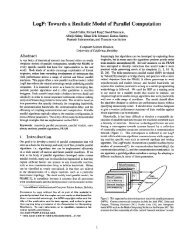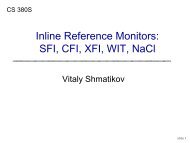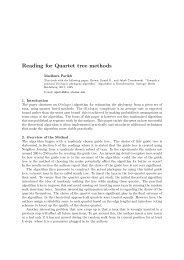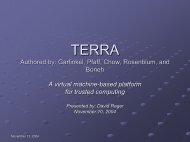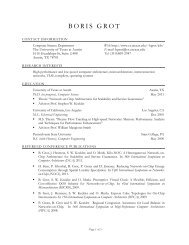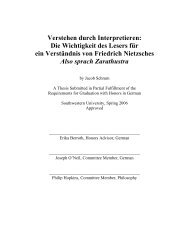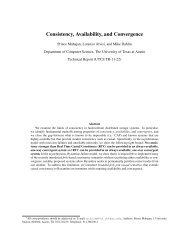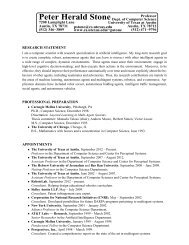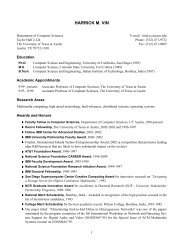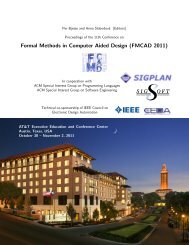A User's Guide to gringo, clasp, clingo, and iclingo
A User's Guide to gringo, clasp, clingo, and iclingo
A User's Guide to gringo, clasp, clingo, and iclingo
Create successful ePaper yourself
Turn your PDF publications into a flip-book with our unique Google optimized e-Paper software.
6 :- flies(tux), -flies(tux).<br />
7 :- flies(tweety), -flies(tweety).<br />
The program has two answer sets. One contains flies(tweety) <strong>and</strong> the other<br />
contains -flies(tweety). Let us now add a new fact <strong>to</strong> the program:<br />
8 flies(tux).<br />
There no longer is any answer set for our new program using classical negation. In fact,<br />
answer set c<strong>and</strong>idates that contain both flies(tux) <strong>and</strong> -flies(tux) violate the<br />
integrity constraint in Line 6. �<br />
3.1.3 Disjunction<br />
Disjunctive logic programs permit connective “|” between a<strong>to</strong>ms in rule heads. A<br />
disjunction is true if at least one of its a<strong>to</strong>ms is true. Additionally, logic programs<br />
have <strong>to</strong> satisfy a minimality criterion, which we do not detail in this guide. The simple<br />
program a | b. has the two answer sets {a} <strong>and</strong> {b} but does not admit the answer<br />
set a, b because it is no minimal model.<br />
In general, the use of disjunction however increases computational complexity [12].<br />
This is why <strong>clingo</strong> 2 <strong>and</strong> solvers like assat [37], <strong>clasp</strong> [20], nomore++ [1],<br />
smodels [51], <strong>and</strong> smodelscc [56] do not work on disjunctive programs. Rather,<br />
<strong>clasp</strong>D [8], cmodels [28, 35], or gnt [33] need <strong>to</strong> be used for solving a disjunctive<br />
program. 3 We thus suggest <strong>to</strong> use “choice constructs” (cf. Section 3.1.10) instead of<br />
disjunction, unless the latter is required for complexity reasons (see [13] for an implementation<br />
methodology in disjunctive ASP).<br />
3.1.4 Built-In Arithmetic Functions<br />
<strong>gringo</strong> <strong>and</strong> <strong>clingo</strong> support a number of arithmetic functions that are evaluated<br />
during grounding. The following symbols are used for these functions: + (addition), -<br />
(subtraction, unary minus), * (multiplication), / or #div (integer division), \ or #mod<br />
(modulo function), ** or #pow (exponentation), |·| or #abs (absolute value), &<br />
(bitwise AND), ? (bitwise OR), ˆ (bitwise exclusive OR), <strong>and</strong> ˜ (bitwise complement).<br />
Example 3.2. The usage of arithmetic functions is illustrated by the logic program: The unique answer set of the<br />
1 left (7).<br />
2 right (2).<br />
3 plus (L + R ) :- left(L), right(R).<br />
4 minus (L - R ) :- left(L), right(R).<br />
5 uminus ( - R ) :- right(R).<br />
6 times (L * R ) :- left(L), right(R).<br />
7 divide1 (L / R ) :- left(L), right(R).<br />
8 divide2 (R #div L ) :- left(L), right(R).<br />
9 divide2 (#div(R,L)) :- left(L), right(R).<br />
10 modulo1 (L \ R ) :- left(L), right(R).<br />
11 modulo2 (L #mod R ) :- left(L), right(R).<br />
12 modulo3 (#mod(L,R)) :- left(L), right(R).<br />
13 absolute1 ( |- R|) :- right(R).<br />
2 Run as a monolithic system performing both grounding <strong>and</strong> solving.<br />
3 System dlv [34] also deals with disjunctive programs, but it uses a different syntax than presented here.<br />
12<br />
program, obtained after evaluating<br />
all arithmetic functions,<br />
can be inspected by invoking:<br />
<strong>gringo</strong> -t



